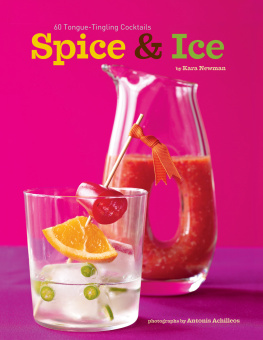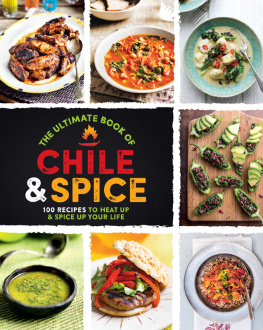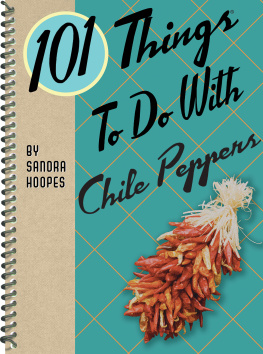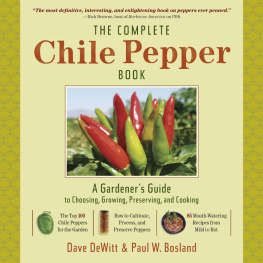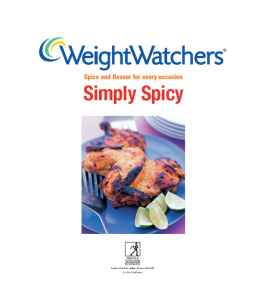To Robert
Thank you to
Gretchen VanEsselstyn and the team at Chile Pepper magazine for championing chile-heads everywhere, and for kindly supporting this project.
Bill LeBlond, Amy Treadwell, Sarah Billingsley, Vanessa Dina, Ben Kasman, Doug Ogan, David Hawk, and Peter Perez at Chronicle Books.
Jonathan Lyons, attorney extraordinaire.
All the bartenders, mixologists, and cocktail experts that contributed recipes, especially Jacques Bezuidenhout, Ryan Magarian, Vanessa Maruskin, Pichet Ong, Tim Stookey, Adam Seger, Willy Shine, Alex Urena, Danny Valdez, Phil Ward, and Janet Zimmerman. Apologies to anyone Ive neglected to mention by name; there were so many inspirations from cocktail menus across the country.
The Astor Center for letting me mix up some of these recipes in a classroom setting, and proving there was an audience for the book. And thanks to everyone who took the classespecially those happy masochists who pressed for the drinks to be even hotter! That was a critical turning point.
My brave band of drink testers (its a tough job, but someone had to do it!): Shaun Adams, Ray Asuncion, Mark Basanta, Simon Binder, Joe Marotta, Sasha The Mensch Martens, Joelle Silverman Miller, Keith Morton, Caroline Pacht, Diana Pittet, Jennifer Sendor, Robert Silverman, Valerie Rodriguez, Tim Stookey, Darrin Towne, Gretchen VanEsselstyn, Kevin Whelan, Ya-Roo Yang, and Chris Zawacki (and apologies for anyone Ive missed!). Thanks for lending your Teflon taste buds and providing thoughtful feedback, support throughout the book-writing process, and some fantastic drink names. Testing out drinks with you was helpful and always a blast.
Melkon Khosrovian of Modern Spirits for providing sensible food-safety guidelines.
David Leite for mentoring me through the book process and telling it like it is and for inspiring by example.
Andy Smith for always encouraging and supporting me, as he has with so many other new writers finding their way, and for quietly and generously offering damn good advice.
Eliott and Naomi Newman; Jennifer and Madelyn Sendor; Alan and Sandy Silverman; Joelle, Laurie, and Rowana Fay Miller.
Robert Silvermanfirst, last, and always. Thanks for bragging and believing.

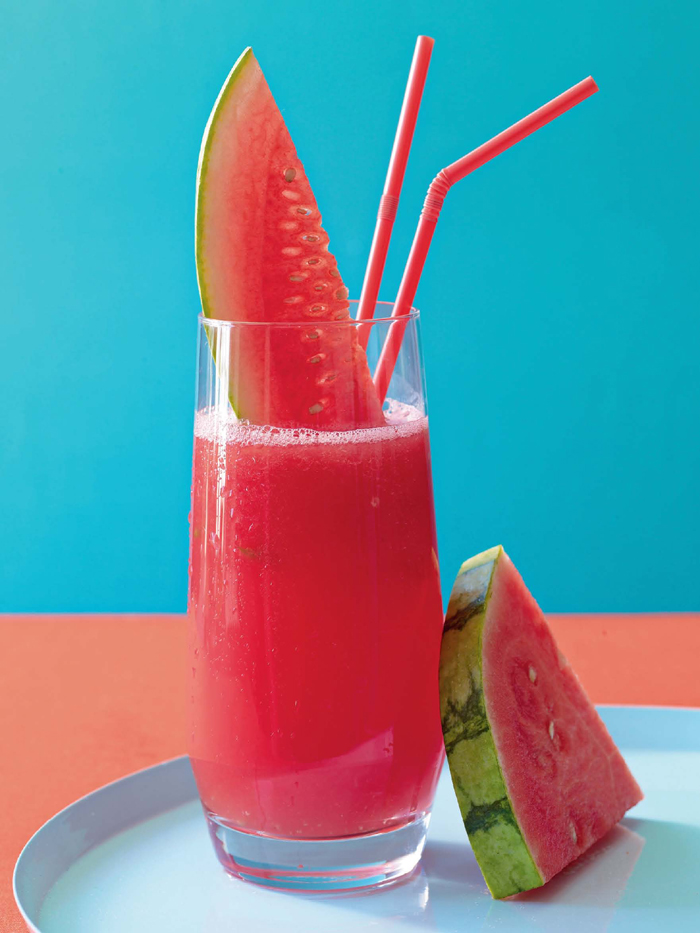
Introduction:
WHY SPICY COCKTAILS?
Spicy cocktails are novel, but theyre more than just a novelty. As a columnist for Chile Pepper magazines High Spirits column, I was assigned to write about topics such as habanero pepperinfused vodka, cocktail pairings for red-hot barbecue, and super-spicy holiday punches.
At first I fretted that I would have trouble filling column space. Boy, was I wrong. Before long, I realized that a significant number of bars and restaurants had at least one spicy drink on cocktail menus to entice adventurous customers and that they tend to sell well. Every mixologist and bar consultant seemed to have a few in his or her repertoire. And during my recipe-testing phases, friends were unusually eager to help try the drinksthey were fun, different, conversation pieces. There was more to write about than Id ever imagined.
In the course of the happy research for my column, I learned two important lessons. First: Heat alone does not make a great drink. But a carefully crafted spicy drink hits all the right flavor notes and leaves a pleasant, faintly glowing heat on the lips and tongue, creating an excitement for the next sip.
Unfortunately, Ive been the victim of bubble gumflavored Cosmos with a shriveled jalapeo tossed on top, a misguided attempt to enliven a stale bar menu. The end result was neither fresh nor enjoyable to drink and underscored that spice alone is not enough. Like any drink, a spicy cocktail should use fresh ingredientsseasonal if at all possible, which is why this book is divided into four seasons. Flavors and heat levels need to be balanced and not too crazy hot or, at the other end of the spectrum, too weak and faintly bitter.
And second: A turbo-charged cocktail gone wrong can be a very painful mistake! Too much Tabasco in a Bloody Mary or a vodka infusion with a cut serrano left in too long means your next party will end abruptly, guests yelping, eyes watering as they flee. Its critical to balance cocktails in terms of both flavor and heat levels. And that requires some guidance and practice.
Even if youre the rare drinker with Teflon taste buds, theres one cardinal rule for crafting spicy drinks. Its not about creating a flame-out of a drinkits about finding the right balance of heat. Master mixologist Jacques Bezuidenhout, who created the award-winning Tabasco-spiked One Hot Minute cocktail, summed it up best: You have to be able to finish the drink and still want another one.
In the interest of readers, I asked professional bartenders, Whats the ratio of cayenne pepper to paprika to rim a martini glass? Is it better to use whole or sliced jalapeos to infuse a bottle of tequila? How do you cool down a drink if the heat gets too intense? This book aims to provide guidelines for making drinks with just the right amount of lip-tingling heat, as well as a few guidelines for toning down spice to adjust your drink, and as a last resort, tips for cooling the burn when thats needed.
But when we get it just right, spicy cocktails are fun and make us feel good. Some liken the capsaicin rush to an athletes endorphin high. Sometimes, all thats needed is a tiny drop of Tabasco to add gentle warmth to an otherwise standard margarita recipethe equivalent of the afterglow from a feel-good run in the park. Other times, the goal is a fiery sizzle, made by adding a daring handful of crushed habaneros to a party punchnot unlike the extreme adrenaline rush of a daredevil skydiving adventure. This is why we become hooked on spicy foodswe love the endorphin rush!
Lets get one common misconception out of the way: spice doesnt always equal Scoville units. Some spiceshot and sweet paprika, anise, and cinnamon, for exampleadd bursts of flavor rather than heat.
Spice & Ice is about finding those bold bursts of flavor and using heat and spice to frame fresh ingredients in a glass, showing them off to best advantage. Spicy drinks can be crazy, they can be elegantbut above all, they have to be delicious!
As a cocktail enthusiast, most likely you already know that theres a wide range of cocktail flavors. Where do spicy drinks fit in?
Sweet/fruity: At one end of the spectrum, you have sweet and fruit-driven cocktails, like daiquiris and Cosmopolitans, and these are the types of flavors that are most frequently associated with cocktails. Done well, sweet/fruity potions are pleasing and easy to drink; done poorly, they tend to be syrupy, sickly-sweet concoctions.
Herbal/floral: The next category can be characterized as herbal or floral. Gin drinks, such as classic martinis and gin and tonics, fall easily within this group, especially considering the wide range of botanicals used in gin. But I also think of cocktails made with light floral elements, such as elderflower, or those with delicate, fragrant characteristics, such as tea-based drinks.
Bitter: After that, I look to bitter cocktailsthe Negroni is a classic example. Drinks made with liqueurs such as Campari, Aperol, or Cynar can be an acquired taste (as can some spicy drinks), although they also may have sweet or herbaceous notes to round out the drink. (I think also of drinks with sweet overtones that use bitters to add complexity and balance as sometimes spanning categories.)

